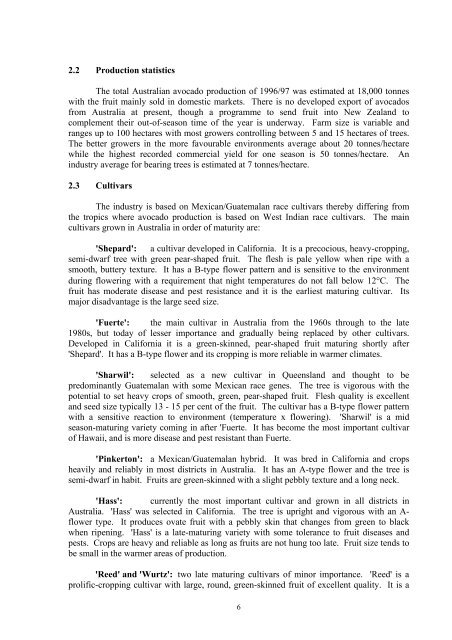Avocado Production in Asia and the Pacific - United Nations in ...
Avocado Production in Asia and the Pacific - United Nations in ...
Avocado Production in Asia and the Pacific - United Nations in ...
Create successful ePaper yourself
Turn your PDF publications into a flip-book with our unique Google optimized e-Paper software.
2.2 <strong>Production</strong> statistics<br />
The total Australian avocado production of 1996/97 was estimated at 18,000 tonnes<br />
with <strong>the</strong> fruit ma<strong>in</strong>ly sold <strong>in</strong> domestic markets. There is no developed export of avocados<br />
from Australia at present, though a programme to send fruit <strong>in</strong>to New Zeal<strong>and</strong> to<br />
complement <strong>the</strong>ir out-of-season time of <strong>the</strong> year is underway. Farm size is variable <strong>and</strong><br />
ranges up to 100 hectares with most growers controll<strong>in</strong>g between 5 <strong>and</strong> 15 hectares of trees.<br />
The better growers <strong>in</strong> <strong>the</strong> more favourable environments average about 20 tonnes/hectare<br />
while <strong>the</strong> highest recorded commercial yield for one season is 50 tonnes/hectare. An<br />
<strong>in</strong>dustry average for bear<strong>in</strong>g trees is estimated at 7 tonnes/hectare.<br />
2.3 Cultivars<br />
The <strong>in</strong>dustry is based on Mexican/Guatemalan race cultivars <strong>the</strong>reby differ<strong>in</strong>g from<br />
<strong>the</strong> tropics where avocado production is based on West Indian race cultivars. The ma<strong>in</strong><br />
cultivars grown <strong>in</strong> Australia <strong>in</strong> order of maturity are:<br />
'Shepard': a cultivar developed <strong>in</strong> California. It is a precocious, heavy-cropp<strong>in</strong>g,<br />
semi-dwarf tree with green pear-shaped fruit. The flesh is pale yellow when ripe with a<br />
smooth, buttery texture. It has a B-type flower pattern <strong>and</strong> is sensitive to <strong>the</strong> environment<br />
dur<strong>in</strong>g flower<strong>in</strong>g with a requirement that night temperatures do not fall below 12°C. The<br />
fruit has moderate disease <strong>and</strong> pest resistance <strong>and</strong> it is <strong>the</strong> earliest matur<strong>in</strong>g cultivar. Its<br />
major disadvantage is <strong>the</strong> large seed size.<br />
'Fuerte': <strong>the</strong> ma<strong>in</strong> cultivar <strong>in</strong> Australia from <strong>the</strong> 1960s through to <strong>the</strong> late<br />
1980s, but today of lesser importance <strong>and</strong> gradually be<strong>in</strong>g replaced by o<strong>the</strong>r cultivars.<br />
Developed <strong>in</strong> California it is a green-sk<strong>in</strong>ned, pear-shaped fruit matur<strong>in</strong>g shortly after<br />
'Shepard'. It has a B-type flower <strong>and</strong> its cropp<strong>in</strong>g is more reliable <strong>in</strong> warmer climates.<br />
'Sharwil': selected as a new cultivar <strong>in</strong> Queensl<strong>and</strong> <strong>and</strong> thought to be<br />
predom<strong>in</strong>antly Guatemalan with some Mexican race genes. The tree is vigorous with <strong>the</strong><br />
potential to set heavy crops of smooth, green, pear-shaped fruit. Flesh quality is excellent<br />
<strong>and</strong> seed size typically 13 - 15 per cent of <strong>the</strong> fruit. The cultivar has a B-type flower pattern<br />
with a sensitive reaction to environment (temperature x flower<strong>in</strong>g). 'Sharwil' is a mid<br />
season-matur<strong>in</strong>g variety com<strong>in</strong>g <strong>in</strong> after 'Fuerte. It has become <strong>the</strong> most important cultivar<br />
of Hawaii, <strong>and</strong> is more disease <strong>and</strong> pest resistant than Fuerte.<br />
'P<strong>in</strong>kerton': a Mexican/Guatemalan hybrid. It was bred <strong>in</strong> California <strong>and</strong> crops<br />
heavily <strong>and</strong> reliably <strong>in</strong> most districts <strong>in</strong> Australia. It has an A-type flower <strong>and</strong> <strong>the</strong> tree is<br />
semi-dwarf <strong>in</strong> habit. Fruits are green-sk<strong>in</strong>ned with a slight pebbly texture <strong>and</strong> a long neck.<br />
'Hass': currently <strong>the</strong> most important cultivar <strong>and</strong> grown <strong>in</strong> all districts <strong>in</strong><br />
Australia. 'Hass' was selected <strong>in</strong> California. The tree is upright <strong>and</strong> vigorous with an A-<br />
flower type. It produces ovate fruit with a pebbly sk<strong>in</strong> that changes from green to black<br />
when ripen<strong>in</strong>g. 'Hass' is a late-matur<strong>in</strong>g variety with some tolerance to fruit diseases <strong>and</strong><br />
pests. Crops are heavy <strong>and</strong> reliable as long as fruits are not hung too late. Fruit size tends to<br />
be small <strong>in</strong> <strong>the</strong> warmer areas of production.<br />
'Reed' <strong>and</strong> 'Wurtz': two late matur<strong>in</strong>g cultivars of m<strong>in</strong>or importance. 'Reed' is a<br />
prolific-cropp<strong>in</strong>g cultivar with large, round, green-sk<strong>in</strong>ned fruit of excellent quality. It is a<br />
6
















